The Large Cap Value style ranks fourth out of the twelve fund styles as detailed in my style rankings for ETFs and mutual funds. It gets my Neutral rating, which is based on aggregation of ratings of 39 ETFs and 727 mutual funds in the Large Cap Value style as of October 17, 2012. Prior reports on the best & worst ETFs and mutual funds in every sector and style are here.
Figures 1 and 2 show the five best and worst-rated ETFs and mutual funds in the style. Not all Large Cap Value style ETFs and mutual funds are created the same. The number of holdings varies widely (from 15 to 1,354), which creates drastically different investment implications and ratings. The best ETFs and mutual funds allocate more value to Attractive-or-better-rated stocks than the worst, which allocate too much value to Neutral-or-worse-rated stocks.
To identify the best and avoid the worst ETFs and mutual funds within the Large Cap Value style, investors need a predictive rating based on (1) stocks ratings of the holdings and (2) the all-in expenses of each ETF and mutual fund. Investors need not rely on backward-looking ratings. My fund rating methodology is detailed here.
Investors seeking exposure to the Large Cap Value style should buy one of the Attractive-or-better rated ETFs or mutual funds from Figures 1 and 2.
Get my ratings on all ETFs and mutual funds in this style on my free mutual fund and ETF screener.
Figure 1: ETFs with the Best & Worst Ratings – Top 5
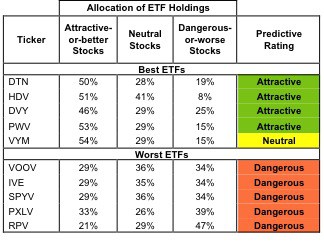
Sources: New Constructs, LLC and company filings
Figure 2: Mutual Funds with the Best & Worst Ratings – Top 5
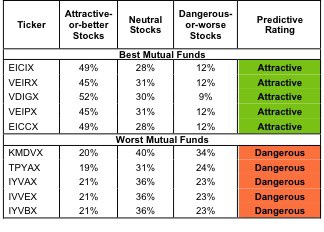
Sources: New Constructs, LLC and company filings
Four mutual funds are excluded from Figure 2 because their total net assets (TNA) are below $100 million and do not meet our liquidity standards.
WisdomTree Dividend ex-Financials Fund (DTN) is my top-rated Large Cap Value ETF and FundVantage Trust: EIC Value Fund (EICIX) is my top-rated Large Cap Value mutual fund. Both earn my Attractive rating.
Rydex S&P 500 Pure Value ETF (RPV) is my worst-rated Large Cap Value ETF and Ivy Funds: Ivy Value Fund (IYVBX) is my worst-rated Large Cap Value mutual fund. Both earn my Dangerous rating.
Figure 3 shows that 448 out of the 1,698 stocks (over 44% of the total net assets) held by Large Cap Value ETFs and mutual funds get an Attractive-or-better rating. However, only 4 out of 39 Large Cap Value ETFs (less than 18% of total net assets) and 12 out of 727 Large Cap Value mutual funds (less than 5% of total net assets) get an Attractive-or-better rating.
The takeaway is: you cannot simply take an ETF or a mutual fund by a style label or its top five holdings. ETFs and mutual funds with the same style label can have drastically different holdings that will translate into significantly different returns for your investment portfolio.
Figure 3: Large Cap Value Style Landscape For ETFs, Mutual Funds & Stocks
As detailed in “Cheap Funds Dupe Investors”, the fund industry offers many cheap funds but very few funds with high-quality stocks, or with what I call good portfolio management.
Investors need to tread carefully when considering Large Cap Value ETFs and mutual funds, as only 4 ETFs and 12 mutual funds in the Large Cap Value style allocate enough value to Attractive-or-better-rated stocks to earn an Attractive rating. To demonstrate the difference between good and bad portfolio management, I have selected a Very Attractive stock from an Attractive mutual fund (EICIX) and a Very Dangerous Stock from a Dangerous mutual fund (TPYAX).
Baxter International Inc. (BAX) is one of my favorite stocks held by Large Cap Value ETFs and mutual funds and earns my Very Attractive rating. Baxter achieved a return on invested capital (ROIC) of 16.5% in 2011; this is in 87th percentile of all Russell 3000 companies. During all 14 years in my model, BAX has generated positive economic earnings. Baxter is not only a great company; it is also an attractive stock due to the market’s pessimistic view of future cash flows. The company’s current stock price (~$61.60) implies that after-tax profits (NOPAT) will permanently decrease by 27%. This seems unlikely given that the company has increased its profits by an average of 12% over the thirteen years in my model. Low expectations and strong historical performance make Baxter an excellent long candidate.
Digital Realty Trust, Inc. (DLR) is one of my least favorite stocks held by Large Cap Blend ETFs and mutual funds and earns my Very Dangerous rating. DLR has misleading earnings – its economic earnings are negative and declining while its reports accounting earnings are positive and increasing. During the eight years in my model, the company has never generated positive economic earnings. Not only is DLR not profitable, it is also overvalued. To justify its current stock price (~$66.95), the company must increase profits by 16% compounded annually for 15 years. That is a lot of future value creation for a company that has never created value. Investors should avoid this stock.
Figures 4 and 5 show the rating landscape of all Large Cap Value ETFs and mutual funds.
Our style rankings for ETFs and mutual funds report ranks all styles and highlights those that offer the best investments.
Figure 4: Separating the Best ETFs From the Worst Funds
Figure 5: Separating the Best Mutual Funds From the Worst Funds
Review my full list of ratings and rankings along with reports on all 38 ETFs and 734 mutual funds in the Large Cap Value style.
Disclosure: I own BAX I receive no compensation to write about any specific stock, sector, style or theme.
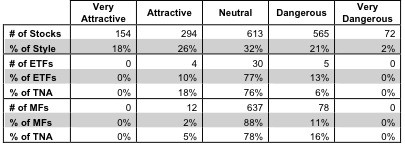
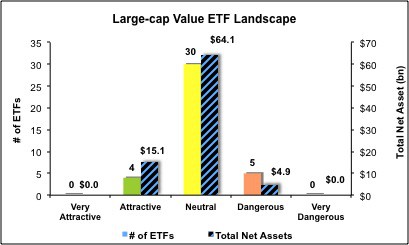
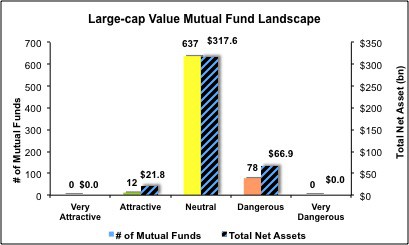
1 Response to "Best & Worst ETFs and Mutual Funds October 2012: Large Cap Value Style"
Keep on writing, great job!